
Henequen is a species of flowering plant in the family Asparagaceae, native to southern Mexico and Guatemala. It is reportedly naturalized in Italy, the Canary Islands, Costa Rica, Cuba, Hispaniola, the Cayman Islands and the Lesser Antilles.
Manfreda was a genus of flowering plants in the family Asparagaceae, subfamily Agavoideae. Along with Polianthes, members are commonly called tuberoses. The generic name honours 14th-century Italian writer Manfredus de Monte Imperiale. All species are now placed in Agave.

Agave tequilana, commonly called blue agave or tequila agave, is an agave plant that is an important economic product of Jalisco, Mexico, due to its role as the base ingredient of tequila, a popular distilled beverage. The high production of sugars named agavins, mostly fructose, in the core of the plant is the main characteristic that makes it suitable for the preparation of alcoholic beverages.

Agave shawii is a species of monocarpic succulent plant in the genus Agave, commonly known as Shaw's agave. It is a rosette-forming plant characterized by glossy, green leaves with toothed margins. After several years of slow growth, the plant puts all of its resources to produce a towering stalk of flowers, and then dies. The death of the flowering rosette is compensated by the growth of numerous clonal pups. This species is segregated into two subspecies, one native to the coast of southwestern California and northwestern Baja California, known commonly as the coast agave, and another native to the Baja California Desert, known as the Goldman agave.

Nolina bigelovii is a flowering plant native to the Southwestern United States, California, and northwest Mexico. It grows in the driest desert areas and at elevations up to 1,500 metres (4,900 ft).

Agave salmiana is a species of the family Asparagaceae, native to central and southern Mexico. It is also reportedly naturalized in South Africa, Italy and Spain, specially in the Canary Islands.

Agave is a genus of monocots native to the hot and arid regions of the Americas and the Caribbean, although some Agave species are also native to tropical areas of North America, such as Mexico. The genus is primarily known for its succulent and xerophytic species that typically form large rosettes of strong, fleshy leaves. Agave now includes species formerly placed in a number of other genera, such as Manfreda, ×Mangave, Polianthes and Prochnyanthes.

Pultenaea scabra, commonly known as rough bush-pea, is a species of flowering plant in the family Fabaceae and is endemic to south-eastern continental Australia. It is an erect or spreading shrub with hairy stems, heart-shaped leaves with the narrower end towards the base, and yellow and red, pea-like flowers.
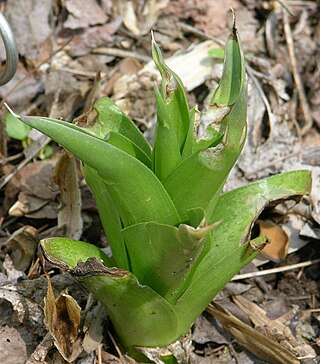
Agave virginica, synonym Manfreda virginica, commonly known as the false aloe, rattlesnake master, American aloe, Virginia agave, and eastern agave, is a species of agave. It is native to the central and southeastern United States and northeastern Mexico, and it is found in prairies, upland rocky glades, and sandy open woods.
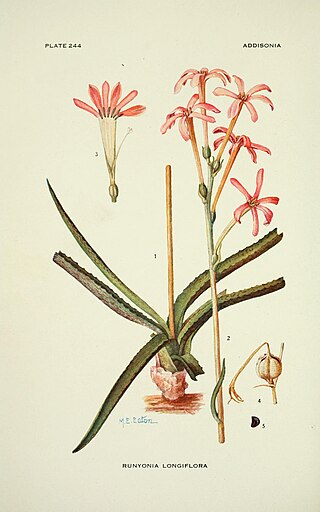
Agave longiflora is a species of flowering plant in the family Asparagaceae that is native to the Lower Rio Grande Valley of Texas in the United States and northern Tamaulipas in Mexico. Common names include amole de río, longflower tuberose, and Runyon's huaco. The type specimens were sent by botanist and photographer Robert Runyon (1881–1968) to the New York Botanical Garden in 1921. Consequently, the species was initially placed in a monotypic genus named in his honour, Runyonia, by Joseph Nelson Rose. The species has been placed in the genus Manfreda, now absorbed into Agave. A. longiflora is a rhizomatous perennial with 3–7 prostrate leaves in a basal rosette. It inhabits hills, terraces and slopes in the semi-arid Tamaulipan mezquital.

Saxifraga aspera is a species of saxifrage known by the common name of rough saxifrage. In German it is known as Rauhhaariger Steinbrech. It is placed in section Trachyphyllum of the genus Saxifraga. There are two subspecies, Saxifraga aspera subsp. aspera and Saxifraga aspera subsp. micrantha. It is a plant of the pan-Arctic tundra and is also found in Europe at moderately high altitudes in the Alps, Pyrenees and northern Apennines.

Agave murpheyi is a species of agave. It is a succulent plant that is found growing only at a few dozen archaeological sites of the ancient Hohokam Indians in southern Arizona and northern Sonora, Mexico. In 1935 there were reported half a dozen sites and in 1970 only two were known. It appears to be a cultivar grown by the Hohokam for food and fiber. Its common names include Hohokam agave, Murphey agave, and Murphey's century plant.

Agave guadalajarana is a smallish Agave species endemic to Mexico. It is native to the Guadalajara region of Jalisco state, and the Ceboruco volcano area of Nayarit state.
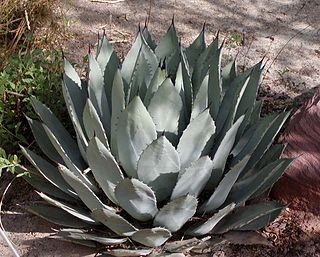
Agave palmeri is an especially large member of the genus Agave, in the family Asparagaceae.
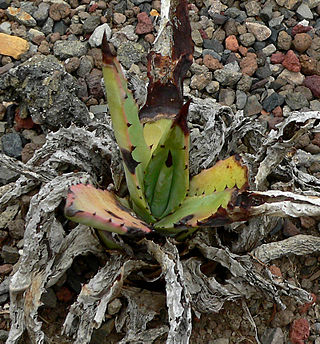
Agave mckelveyana, common name McKelvey's century plant, is a species endemic to west-central Arizona, at elevations of 800–2,200 m (2,600–7,200 ft).
Agave sileri is a species of Agave known only from coastal areas in the States of Texas and Tamaulipas. It grows on open locations with clay soil, at elevations below 100 m. Siler's tuberose is a common name.
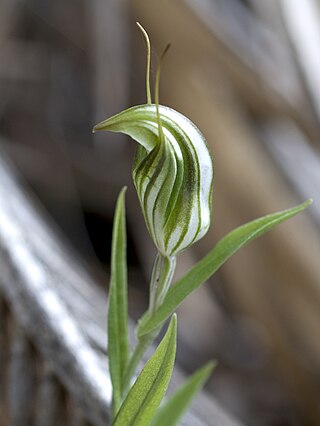
Pterostylis scabra, commonly known as the green-veined shell orchid, is a species of orchid endemic to the south-west of Western Australia. As with similar orchids, the flowering plants differ from those which are not flowering. The non-flowering plants have a rosette of leaves but the flowering plants lack a rosette and have a single flower with leaves on the flowering spike. This greenhood has a white flower with green and pale brownish-fawn stripes and a long, curved protruding labellum. It is found in inland areas between Kalbarri and Esperance.

Mangaves are plants formerly given the nothogenus name × Mangave. They are derived from hybridizing species in the genus Agave and the former genus Manfreda. Manfreda is now included in Agave, so the scientific name is obsolete. Mangaves are often employed as ornamental plants in dry environments, as they possess traits of durability found in both parents. Around 30–40 cultivars were available as of 2020.

Agave gigantensis is a large, flowering agave plant found in Baja California Sur, Mexico. Its name is derived from the area of origin, not its large size. The plant is distinguishable by its red and purple leaves during flowering season. It is able to survive in harsh, rocky conditions and prefers dry and warm environments. The flowers of A. gigantensis are arranged in small clusters which diverge from a main branch. Unlike many other agave plants, A. gigantensis has been traditionally used in food and medicine by communities of western Mexico.
Hibbertia scabra is a species of flowering plant in the family Dilleniaceae and is endemic to the north of the Northern Territory. It is a small shrub with hairy foliage, linear to narrow elliptical leaves and yellow flowers arranged singly near the ends of branches with about fifty stamens arranged around two densely scaly carpels.
















